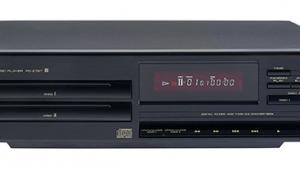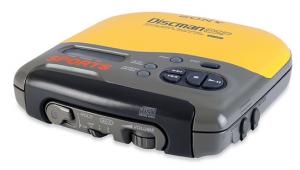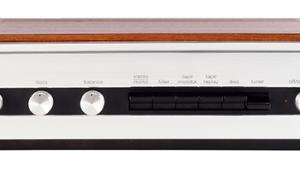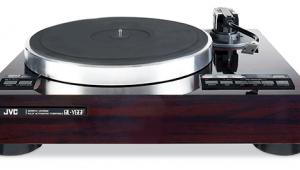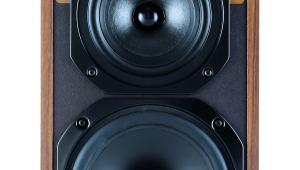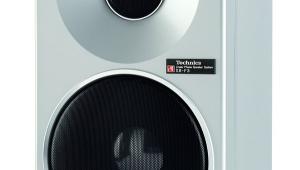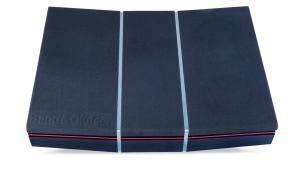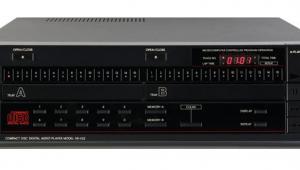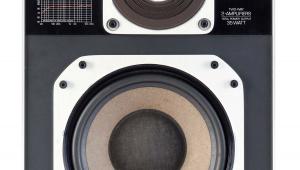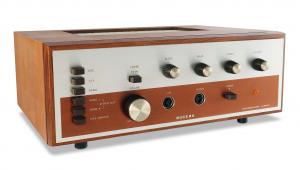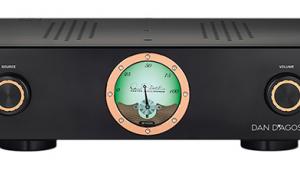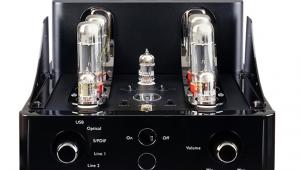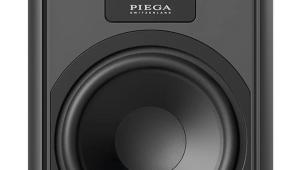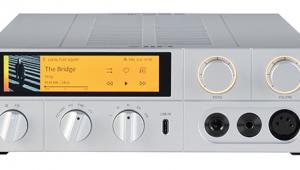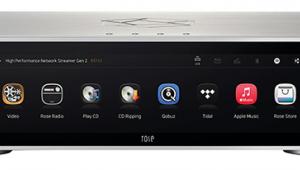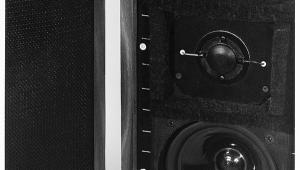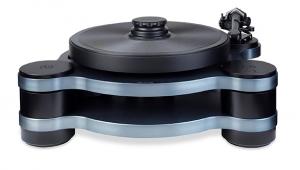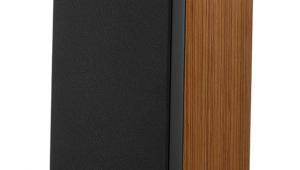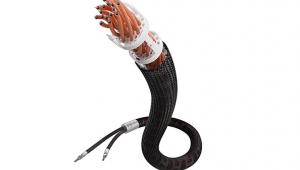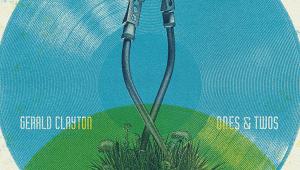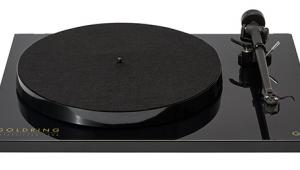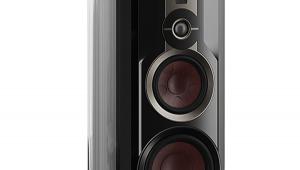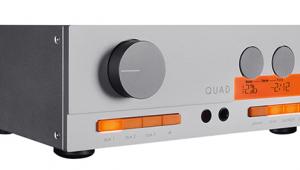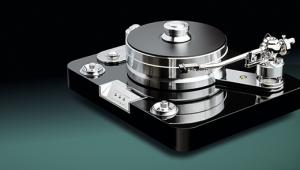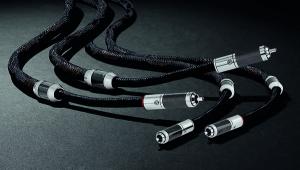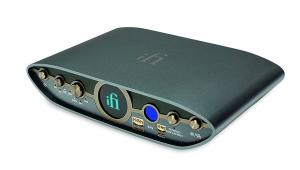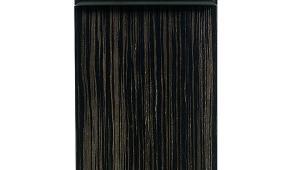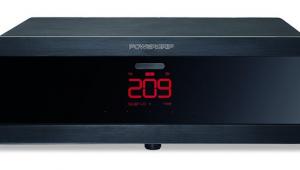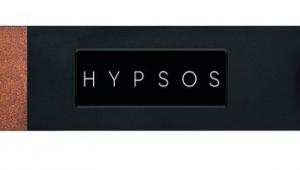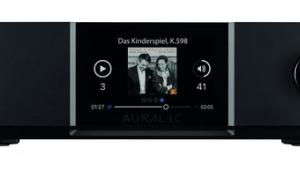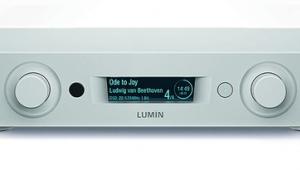Pioneer PL-12D turntable
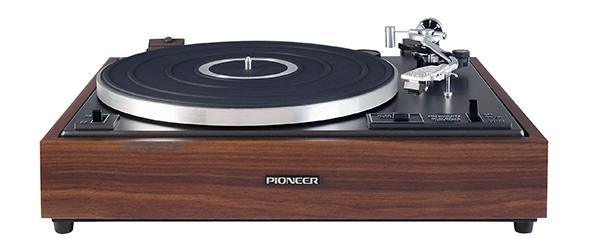

Many Hi-Fi News readers will have fond memories of Pioneer’s PL-12D turntable. A best seller when new and one of the models that has enjoyed a resurgence in popularity with the vinyl revival, generations of audiophiles have, at one time or another, had one of these decks in their systems. Introduced in 1973, it came at just the right time to benefit from the rapidly increasing growth in affordable hi-fi, setting music lovers on a path to better and (usually) more expensive things.
Nobody does it better
With a product as well-loved and well-remembered as the PL-12D, it is perhaps inevitable that a certain amount of mythology has built up around it. Let’s begin by setting the record straight, so to speak. Firstly, the PL-12D was blamed by some as being partly responsible for the downfall of our home-grown, mass-market turntable industry, much as Toyota and Datsun had done with cars, Honda and Kawasaki had done with motorcycles and Canon and Nikon had done with cameras. There may have been a grain of truth in this, but it could also be argued that Pioneer simply better served the aspirations of new consumers in the 1970s than the established UK brands.
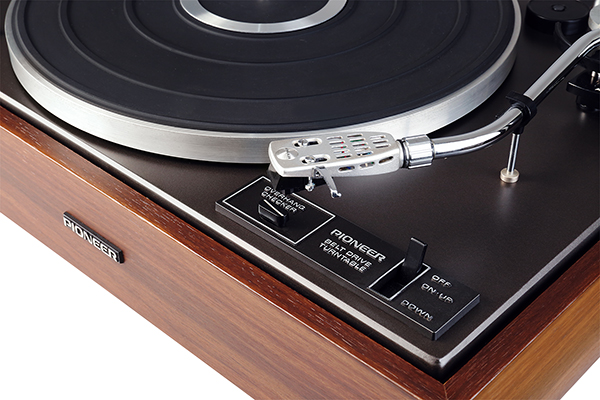
This view is supported by the PL-12D’s price, which was not especially low for what it offered. The importers initially placed it at just over £60 and that did not include a fitted cartridge. A suitable one (such as one of Shure’s M75 models, as fitted to our example) would have added another £12 to £15 to that. Eventually the price from some dealers settled around £40 but there was still plenty of choice at that level. For example, a Garrard SP25 Mk IV, with a plinth, dust cover, leads and cartridge, had a list price of £38 but the discounters would happily sell you one for less than £19.
Yesterday’s tech
Similarly, a Goldring GL75 with plinth and lid had a similar list price to the PL-12D but a search through the hi-fi magazines of the day would have found you one ready to go with a Goldring G800 cartridge for around £40 without difficulty. Both of these rivals were idler-driven of course, yesterday’s technology in the PL-12D’s heyday. Still, there were plenty of belt-drive alternatives also available – how about a Philips GA 212, a B&O Beogram 1001 or a Sony PS-5520? All could be bought for PL-12D money, sometimes less when it is remembered that all of them came with factory-fitted cartridges.
One of a kind
Another fanciful feature of the PL-12D legend is that it was in some way unique. This is also not the case, for even though automatic turntables with heavyweight arms were still very much the norm at the time there were plenty of fully manual belt-driven alternatives which were widely distributed. As well as the Philips and B&O models mentioned above, there was the Connoisseur BD2, a popular British model designed with the enthusiast very much in mind. Many were sold in kit form but even fully assembled it was considerably cheaper than Pioneer’s deck. And because most of the other Japanese majors made something similar to the PL-12D, if the cards had fallen differently maybe we would be now talking about a Sanyo or a Hitachi turntable instead...
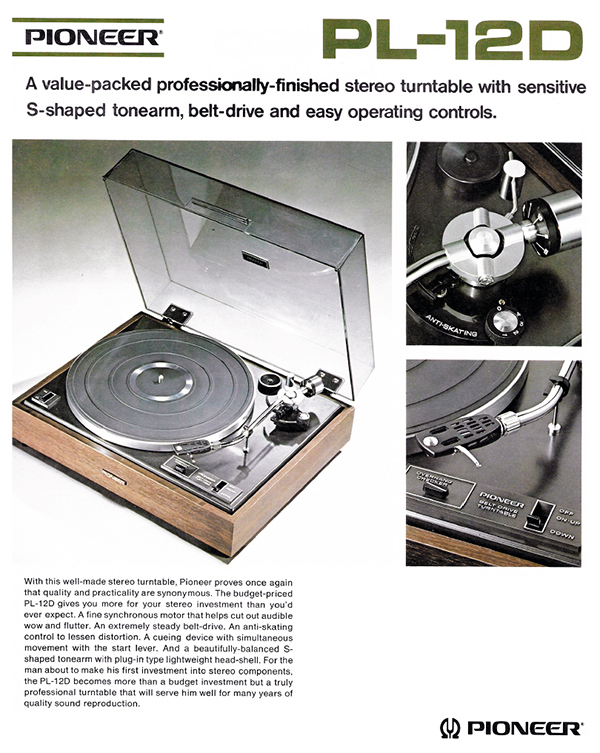
In the event, it was the Pioneer PL-12D that rose to prominence, even though Pioneer itself offered plenty of other options – its 1974 UK catalogue contained nine turntables overall. Most gained little or no traction in the market here, with models such as the PL-12S (essentially a PL-12D with an electronic device to stop the motor at the end of the record) and the PL-15D (basically a PL-12D with auto return) being now largely forgotten. So why was this turntable in particular so well loved? One key point in its favour was that it looked and felt like something more special than it really was. The specification ticked a lot of boxes. Belt drive, removable lightweight headshell, S-shaped arm, 12in spun alloy platter and plenty of polished, precision finished metal... all made it seem leagues ahead of the familiar BSRs, Collaros and Garrards with which many listeners had started their hi-fi journeys. Pioneer’s lightweight arm could use a better class of cartridge than many of the turntables at its price too, so if you could stretch to a Shure V-15, the PL-12D would make the best of it. Moreover, this deck allowed the owner to believe that they’d moved on from stereos and music centres to ‘proper’ hi-fi – a claim that was not entirely unreasonable. The PL-12D was later replaced by the PL-112D, a larger and more modern-looking design. However, some of the magic had been lost along the way and this model never quite inspired the same affection as its famous predecessor.
Cue the music
Seeing one again is like greeting a long-lost friend, but even if you’ve never encountered one before there are few old hi-fi products that are simpler to appreciate and use. Sure enough, the power switch is slightly unusual as it’s part of the cueing lever, so the motor does not start when the arm is moved, as is common with this type of machine. Instead the PL-12D’s lever is moved to an intermediate position which sets the record in motion. Then, moving it further drops the stylus with a smooth, hydraulically damped action.
In the arc of the arm between the rest and the edge of the waiting vinyl is a curious little widget called the ‘overhang checker’. This is a small platform with a line scribed on it – when it is raised the stylus tip should extend exactly as far as the line. This is something of a gimmick, and Sony’s idea of printing a conventional alignment protractor on the back of the mat was far more sensible and practical.
Strictly, the PL-12D has a sprung top-plate rather than a suspended sub-chassis and the springs are quite firm by the standards of some of Pioneer’s rivals. The arm, on the other hand, is beautifully finished and moves with delicate ease. It is not particularly sophisticated in its design but is made to a good standard. As can be seen from the pictures of our now over 50-year-old example, the chrome still looks as lustrous as the day it was made. Finding a PL-12D as original as ours is not easy as many have been modified or otherwise tinkered with by their owners.
Changing the headshell for an SME model was once a popular thing to do but, like putting a Porsche gear knob on a Mini, it makes very little difference in practice. The mat, arm wiring and signal cables were also often changed, along with experimentation with different methods of damping the springs and various anti-resonance treatments inside the plinth. Needless to say, our extra-virgin PL-12D has escaped all this adulteration and is still, essentially, factory specification.
![]() Tim listens
Tim listens
It doesn’t take much listening to hear why these were so popular. This PL-12D and Shure M75 combination delivers a brisk sound with plenty of get up and go. Compared to the class of turntable from which the original owner was probably upgrading, the clarity and definition are in another league, with a pin-sharp focus to the upper midband and treble.
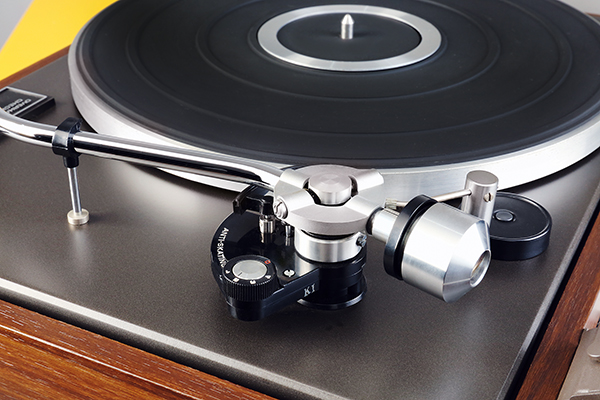
Another key area of improvement would have been motor and drive system, both of which are basically silent. Subjective pitch stability, while not being up to the standards of the direct-drive turntables which by the end of the decade would push the PL-12D aside, is still every bit as good as it needs to be for relaxing and engaging musical enjoyment. It really is difficult to fault this turntable in terms of what it was, but nothing is perfect.
It’s the lower registers where the limitations of the PL-12D’s design are most apparent. The M75 isn’t a particularly warm-sounding cartridge and this usefully disguises the turntable’s limited bass precision. Percussion instruments, plus the larger members of an orchestra string section, sound slow and ill-defined compared to what is possible. And this situation becomes even more apparent with increasing volume levels, due to acoustic feedback, if the turntable is not placed with care. Heavily plucked double bass notes in particular seem to go on for too long, smearing themselves over the rest of the music.
In listening to Beethoven’s six Bagatelles [Für Elise/Eroica-Variationen, Philips Digital Classics 412-227-1], I found that the PL-12D did a fine job of the sometimes difficult task of reproducing piano music convincingly. The pieces contain many rests and extended silences, and during these the turntable’s almost silent motor was demonstrated to good effect.
Tickled pink
A pleasing sense of clarity was present around each of the individually struck notes, although I was aware of some hardness of tone in those further up the musical scale when compared to results obtained from a more premium turntable design. Some subtle wavering and wateriness was also noted during sustained notes, and in the longer, slower sequences, but this is to be generally expected from a basic belt-drive design.
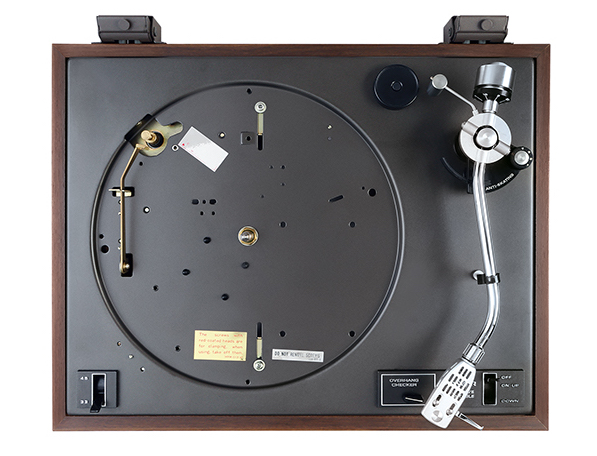
Since it was released in the same year that the PL-12D was introduced to the UK market, it would have been remiss not to audition Pioneer’s deck with Pink Floyd’s The Dark Side Of The Moon [EMI SHVL 804], as I’m sure many new owners did in their first few weeks and months of ownership. The big, swirling soundscapes of the first side of the album were vividly spread across the listening room in a performance which above all sounded authentic and period-correct. Whatever other shortcomings the PL-12D might have, its ability to produce immersive, exciting and three-dimensional experiences from material such as this at a modest, attainable price must have been what made it one of the ‘must hear’ products of the era.
And with that, the whole PL-12D story finally makes sense. Yes, it was technically conventional and priced similarly to many very capable competitors, but it delivered the goods. Then, just as now, if you spent more you got more, but the Pioneer PL-12D got close enough without fuss or complication.
Buying secondhand
This is still a highly capable machine which can rival anything up to its price point, new or used. I suspect that the majority of PL-12D buyers today have had one before and know exactly what they are getting, but if you missed these the first time around it is worth seeking out and hearing a good one. For those who find the sound of the Shure M75 moving-magnet cartridge a little too tame, there are many modern alternatives, the Audio-Technica AT-VM95E or the Ortofon 2M Red being two good (and affordable) options.
The PL-12D is straightforward to assess as a secondhand buy. There are also many to choose from, so there’s no need to settle for anything that’s second rate. Ensuring that there isn’t excessive play in the arm bearings is a good place to start, followed by making sure that the platter rotates smoothly and at the right speed. The centre bearing can seize up but it isn’t difficult to dismantle and re-lubricate – standard 3-in-1 oil is the best thing to use. The motor is reliable. There is a small hole next to the pulley which allows oil to be dropped in, and some owners used this rather too often, resulting in a sticky mess in the bottom of the cabinet.
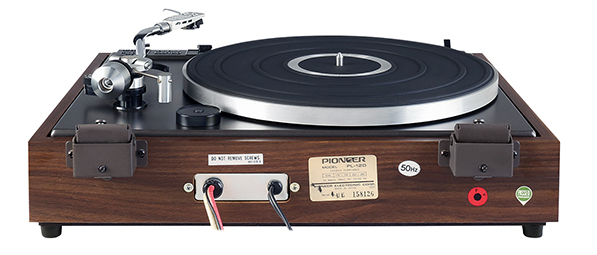
Apart from general scruffiness (some PL-12Ds have had a hard life as they’ve been passed through the hands of many owners), the worst things that affect this model are amateur modifications. A tidy, original example is worth holding out for. Most commonly, not all headshells have identical contact dimensions and a replacement type may not make good connection with the terminals inside the arm. This can result in intermittent sound, hum or the loss of one of the channels.
Hi-Fi News Verdict
What more really needs to be said about the Pioneer PL-12D turntable? Its attraction remains the same after a full 50 years – specifically, it looks good, sounds good and delivers an experience that’s unmistakably ‘real’ hi-fi without fuss or complication. A simple, sturdy construction and high-quality engineering combine to make something which is still easy to find in good functional condition today.
Sound Quality: 75%

